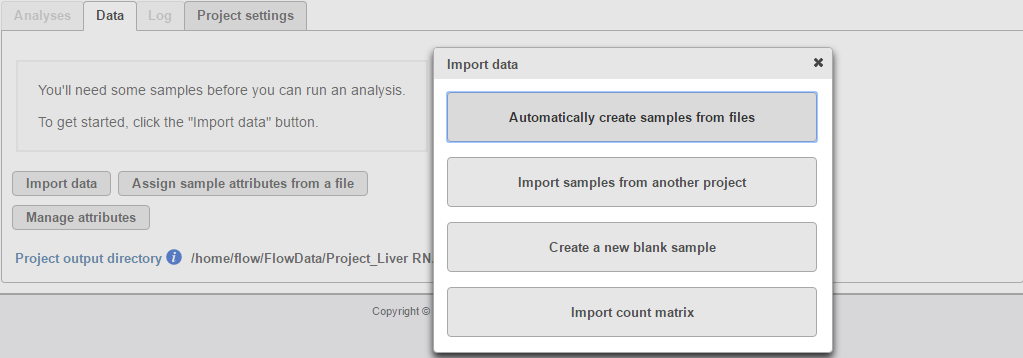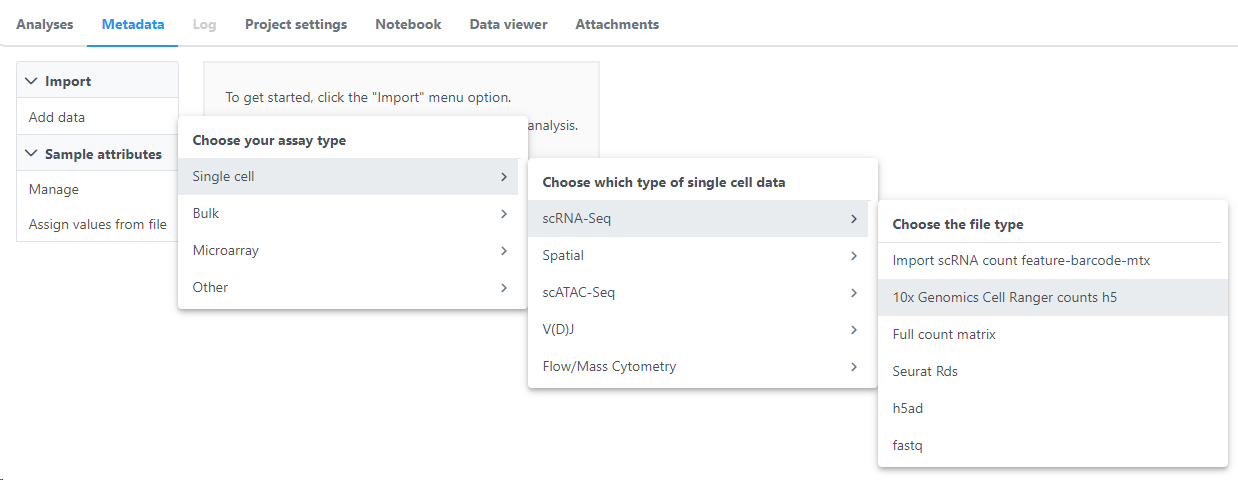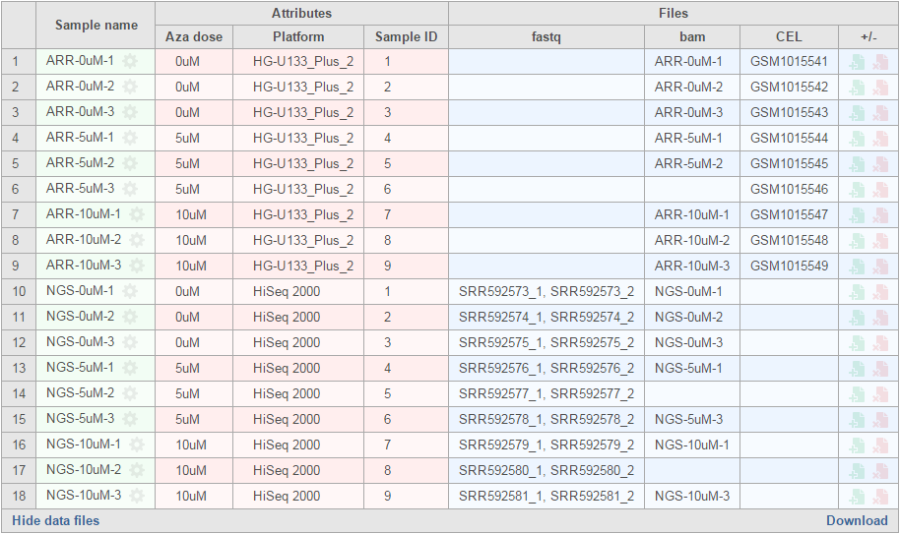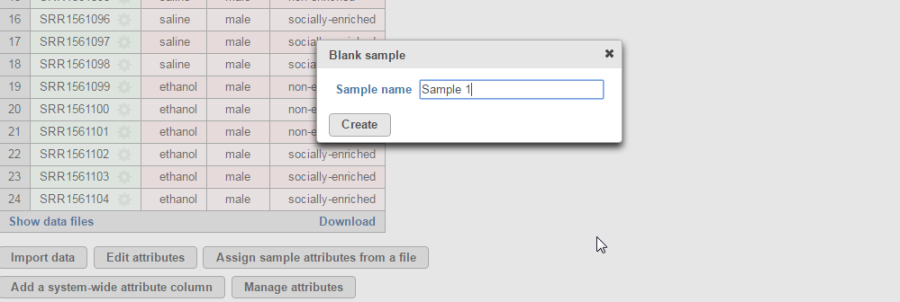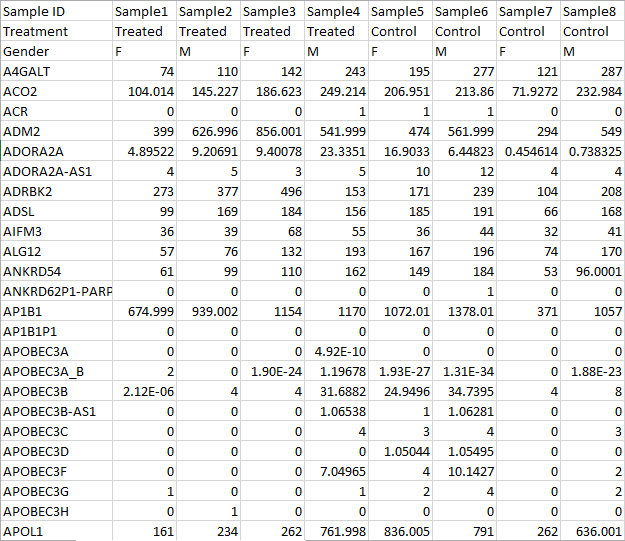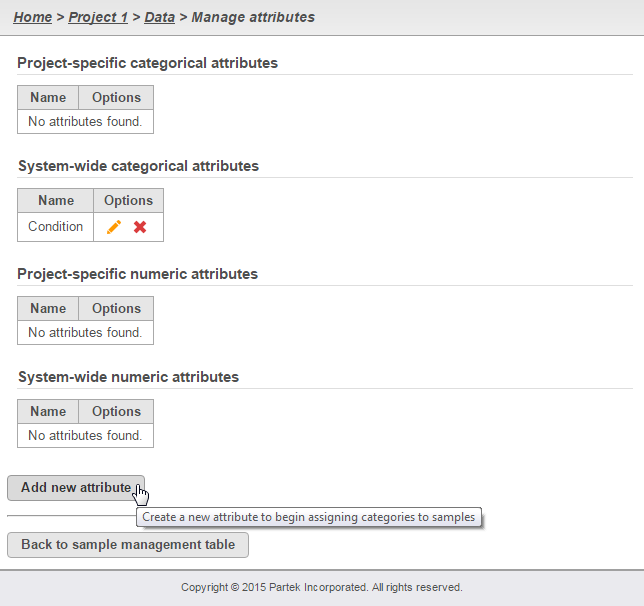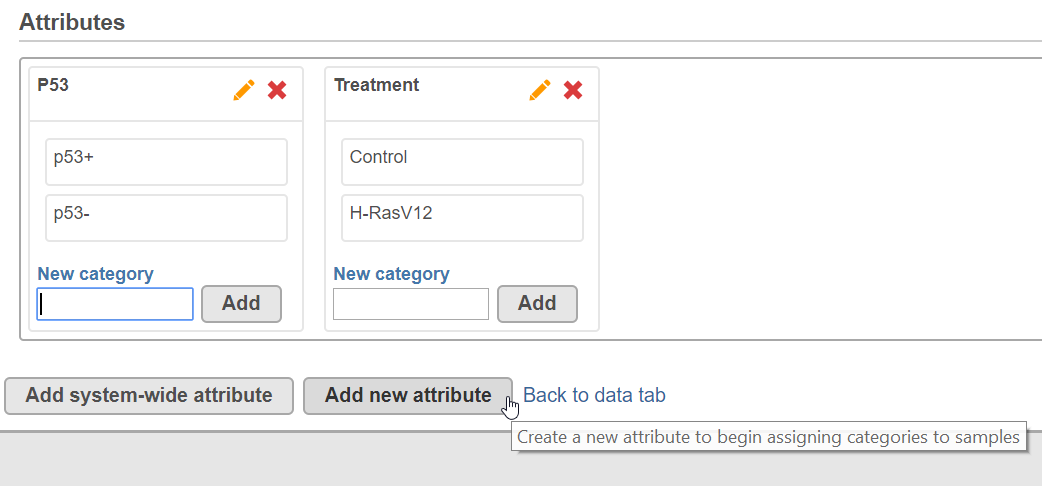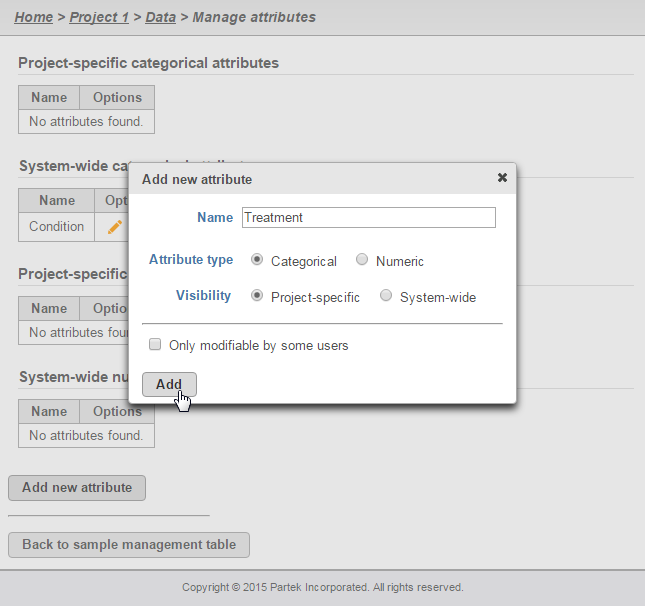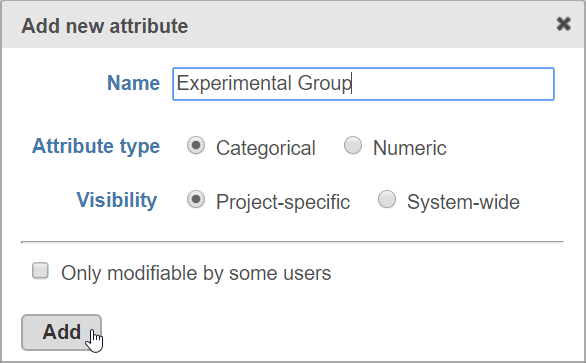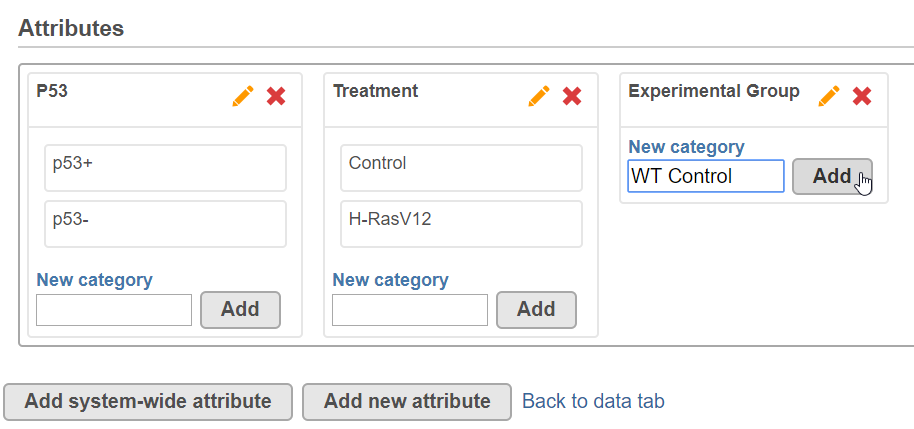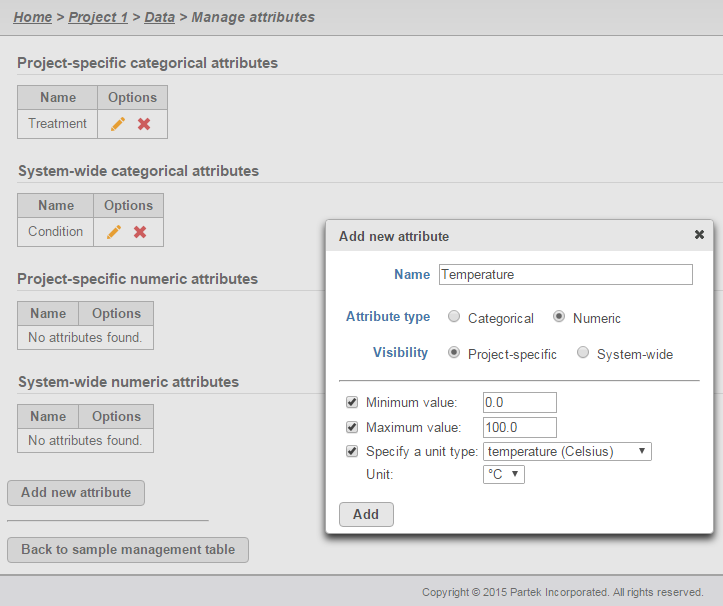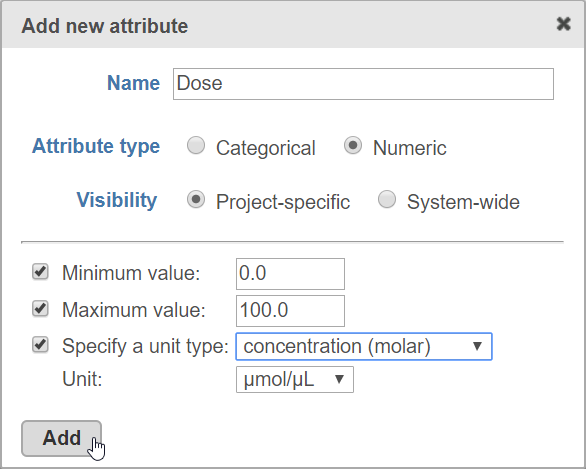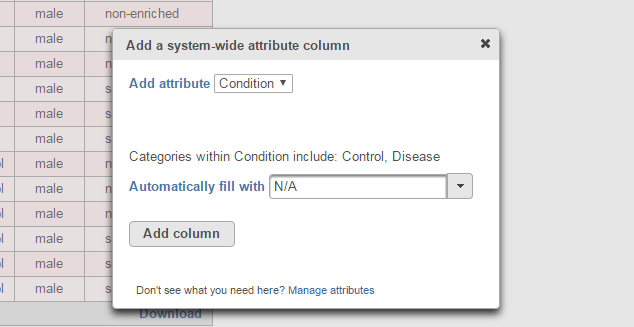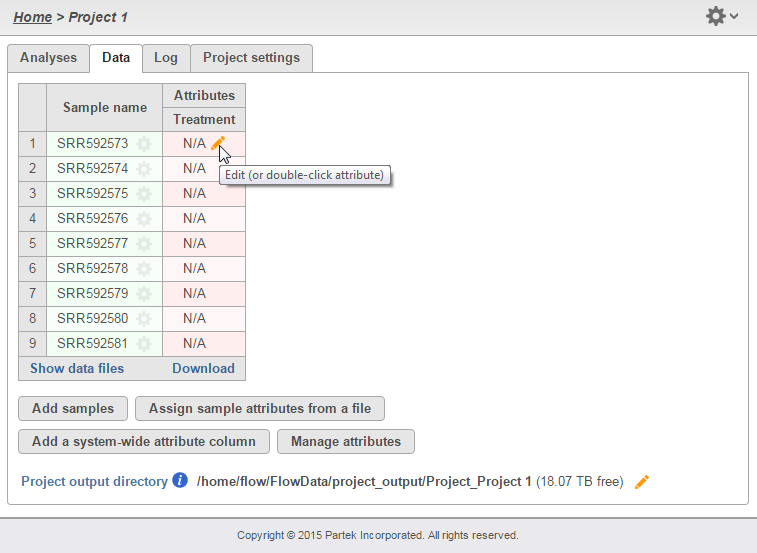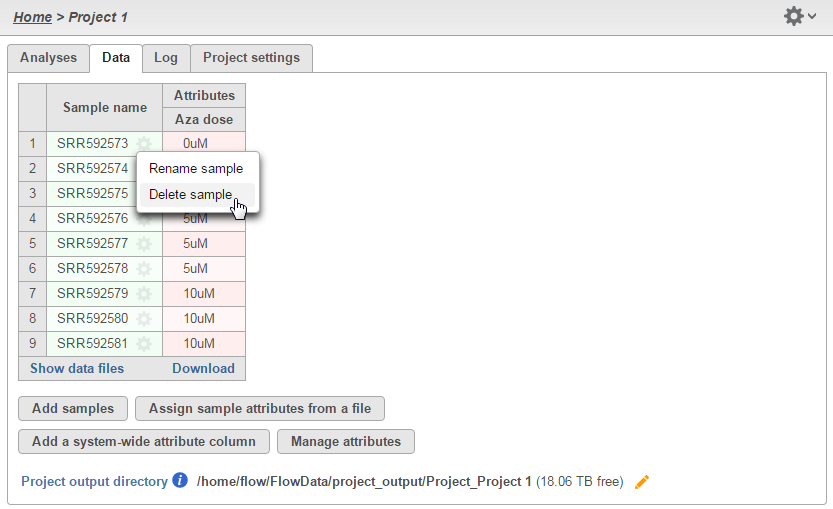Page History
The Partek® Flow® Data Tab is where users can add samples, Metadata Tab has an option to import data, and assign is where sample/cell attributes are managed. This is also where users can modify the location of the project output folder.
| Table of Contents | ||||||
|---|---|---|---|---|---|---|
|
Adding samples
...
Import data
The Metadata tab can be used to import data. To add samples to the project, click Import data. Four options will be displayed.
click Add data under Import, different import options are displayed using the cascading menu (Figure 1).
| Numbered figure captions | ||||
|---|---|---|---|---|
| ||||
Automatically create samples from files
This method adds samples by creating them simultaneously as the data gets imported into a project. The sample names are assigned automatically based on filenames.
Before proceeding, it is ideal that you have already copied transfer the data you wish to analyze in a folder (with appropriate permissions) within the Partek Flow server. Please seek assistance from your system administrator in uploading your data directly.
Select the Automatically create samples from files button. The next screen will feature a file browser that will show any folders you have access to in the Partek Flow server (Figure 2). Select a folder by clicking the folder name. Files in the selected folder that have file formats that can be imported by Partek Flow will be displayed and tick-marked on the right panel. You can exclude some files from the folder by unselecting the check mark on the left side of the filename. When you have made your selections, click the Create sample button.
| Numbered figure captions | ||||
|---|---|---|---|---|
| ||||
Alternatively, files can also be uploaded and imported into the project from the user's local computer -only use this option if your file size is less than 500MB. Select the My computer radio button (Figure 3) and the options of selecting the local file and the upload (destination) directory will appear. Only one file at a time can be imported to a project using this method.
| Numbered figure captions | ||||
|---|---|---|---|---|
| ||||
...
The columns in the expanded view show the files associated with each sample. Files are organized by file type. Any filename extensions that indicate compression (such as .gz) are not shown.
| Numbered figure captions | ||||
|---|---|---|---|---|
| ||||
...
Click the green icon ( ) to associate additional files or the red icon ( ) to dissociate a file from a sample. You can manually associate multiple files with one sample. Dissociating a file from a sample does not delete the file from the Partek Flow server.
Import samples from another project
This method adds samples from previously created projects (within the same Partek Flow server) to a new project. This option is useful for re-analyzing a dataset in a new project, analyzing a subset of a data from a previous project, or combining data from different projects
Select the Import samples from another project button. A dialog box will allow selection of the samples (Figure 5). The drop down menu Project lists the existing projects that the current user has access to. They may be previous projects from the same user, previous projects from collaborators, or (if the user has an administrative account) all the projects in the Partek Flow server.
Click the Project dropdown menu to select an existing project. Choose the samples you wish to add to your new project by clicking the check box next to the Sample name. Files that will be imported to the new project are shown in the right column. You also have the option to select some of the Attributes that were associated with the samples from the original project. Once you make your selection, click the Import button. These samples will now appear in the Sample management table in the Data tab.
Note that if you are importing samples from a project that has some data imported as count matrix (see next section), you must import all the samples from that original project. Clicking on one box selects all other samples, as well.
| Numbered figure captions | ||||
|---|---|---|---|---|
| ||||
Create a new blank sample
Samples can be added one at a time by selecting the Create a new blank sample option (Figure 65). In the following dialog box, type a sample name and click Create. This process creates a sample entry in the sample management table but there is no associated file with it, hence it is a "blank sample."
...
Mouse over the +/- column and click the green icon ( ) to associate a file(s) to the sample. Perform the process for every sample in your project.
| Numbered figure captions | ||||
|---|---|---|---|---|
| ||||
Adding Files to an existing project
Additional samples can be added to any existing project simply by opening the project, going to the Data tab, and clicking the Import data button (Figure 7). Three options to add samples will be revealed.
| Numbered figure captions | ||||
|---|---|---|---|---|
| ||||
Importing count matrix data
Alternatively, if you have a matrix of data, such as raw read count data in text format, select Import count matrix. The requirements of this text file are listed below:
- The file contains numeric values in a tab-delimited format, samples can be on rows while features (e.g.gene names) are in columns, or vice versa
- The file contains unique sample IDs and feature IDs
- If the data contains sample attribute information, all these attributes have to be ether
- The leftmost columns when samples are on rows (Figure 86)
- The first few rows when samples are on columns (Figure 97)
| Numbered figure captions | ||||
|---|---|---|---|---|
| ||||
...
| Numbered figure captions | ||||
|---|---|---|---|---|
| ||||
Like all other input files, you can upload the file from the Partek Flow server, My Computer or via a URL. Uploading the file brings up a file preview window (Figure 8). The preview of the first few rows and columns of the text file should help you determine on which rows/columns the relevant counts are located (the preview will display up to 100 rows and 100 columns). Inspect the text preview and indicate which row the data header begins.the orientation of the text file under File format>Input format.
If the read counts are based on a compatible annotation file in Partek Flow, you can specify that annotation file under File formatGene/feature annotation. Select the appropriate genome build and annotation model for your count data.
Select the Contain sample attributes checkbox if your data includes additional sample information.
| Numbered figure captions | ||||
|---|---|---|---|---|
| ||||
Figure 9 The example above is showing an example text file contains with samples listed on rows, the first column is sample ID, sample attributes are in column 2 and column 3. Gene count starts from column 4 with gene ID in row one. The gene ID . The gene ID is compatible with the hg19 RefSeq hg19 RefSeq Transcripts - 2016-08-01 annotation model. annotation model. Under the Column information and Row information sections, indicate the location of the Sample ID, which in this case is on Column 1. Indicate the sample attribute location by marking where it starts, which in the example is at Column 2. Mark the Feature ID, which in this case are gene IDs and starts at Column 4 .
If the data has been log transformed, specify the base under Counts format.
Project output directory
The project output directory is the folder within the Partek Flow server where all output files produced during analysis will be stored.
...
The user has the option of specifying an existing folder or creating a new one as the project output directory. To do so, click the icon next to the directory and specify or create a new folder in the dialog box.
Sample Annotation
After samples have been added in the project, additional information about the samples can be added. Information such as disease type, age, treatment, or sex can be annotated to the data by assigning the Attributes for each sample.
Certain tasks in Partek Flow, such as Gene-Specific Analysis, require that samples be assigned attributes in order to do statistical comparisons between groups or samples. As attributes are added to the project, additional columns in the sample management table will be created.
Sample attributes
Attributes can be managed or created within a project. Under the Data tab, click the button to open the Manage attributes page (Figure 109).
| Numbered figure captions | ||||
|---|---|---|---|---|
| ||||
To prepare for later data analysis using statistical tools, attributes can either be categorical or numeric (i.e., continuous).
Adding a categorical attribute
For categorical attributes, there are two levels of visibility. Project-specific categorical attributes are visible only within the current project. System-wide categorical attributes are visible across all the projects within the Partek Flow server, and are useful for maintaining uniformity of terms. Importing samples in a new project will retain the system-wide attributes, but not the project-specific attributes.
...
To add a categorical attribute in the Manage attributes page, click the Add new attribute (Figure 1110). In the dialog box, type a Name for the attribute, select the Categorical radio button next to Attribute type, select the visibility of the attribute and then click the Add button.
| Numbered figure captions | ||||
|---|---|---|---|---|
| ||||
Individual categories for the attribute must then be entered. Enter a name of the New category and click Add in the New category text box and click Add (Figure 11). The Name of the new category will show up in the table. The category can also be edited by clicking or deleted by clicking . Additionally, sub-categories can be added by clicking in the Options column. After all the categories have been added to this attribute, click Close to proceed.(visible on mouse-over). Repeat to add additional categories within the attribute.
Repeat the process for additional attributes of the samples in your study. When done, click Back to sample management table. Categorical attributes will default to Project-specific visibility. An additional feature to facilitate the controlled vocabulary in Partek Flow is the integration of terms used by SNOMED CT, a healthcare terminology used for electronic health records. They can be added easily by managing the categories of an attribute and selecting Import terms from SNOMED CT shown in Figure 12. Available terms include those for body structure, specimen, clinical findings, or organism. Select multiple terms from SNOMED CT by holding Ctrl key on the keyboard while clicking the mouse to select. These terms will become new top level categories in your attribute. When terms are imported from SNOMED CT, the Term depth indicates the number of sublevels that will also be imported as subcategories in your attribute.
Click an attribute name to drag and drop can change the order of the attributes displayed on the data tab. Click on group name to drag and drop vertically can change the order of the group name, which can be reflected on visualization.
| Numbered figure captions | ||||||
|---|---|---|---|---|---|---|
|
| |||||
Adding a numeric attribute
To add a numeric attribute in the Manage attributes page, click the Add new attribute. In the dialog box (Figure 13), type a Name for the attribute, select the Numeric radio button next to Attribute type, and then click the Add button. Some optional parameters for numeric attributes include the Minimum value, Maximum value, and Units. When done, click Add to return to the Manage attributes page. Repeat the process add more numeric attributes. When done, click Back to sample management table.
| Numbered figure captions | ||||
|---|---|---|---|---|
| ||||
Adding a system-wide attribute
Since system-wide attributes do not have to be created by the current user, they only need to be added to the sample management table in a project.
...
For an System-wide categorical attribute, the different categories are listed and you have the option of pre-filling the columns with N/A (or any other category within the attribute). Click Add column and you will return to the Data Tab.
| Numbered figure captions | ||||
|---|---|---|---|---|
| ||||
Assigning categories or values to attributes
After adding all the desired attributes to a project, the sample management table will show a new column for each attribute (Figure 15). The columns will initially as "N/A", as the samples have not yet been categorized or assigned a value. To edit the table, click Edit attributes. Assign the sample attributes by using a drop down for categorical attributes (controlled vocabulary) or typing with a keyboard for numeric attributes.
| Numbered figure captions | ||||
|---|---|---|---|---|
| ||||
When all the attributes have been entered, click Apply changes and the sample management table will be updated. After editing the sample table, make sure there are no fields with blank or N/A values before proceeding. To rename or delete attributes, click Manage attributes from the Data tab to access the Manage attributes page. Note that you cannot delete an attribute if a sample is assigned to it.
Assigning attributes using a Sample Annotation Text File
Another way to assign attributes to samples in the Data tab is to use a text file that contains the table of attributes and categories/values. This table is prepared outside of Partek Flow using any text editing software capable of saving tab-separated text files.
Using a text editor, prepare a table containing the attributes. An example is shown in Figure 16. There should only be one tab between columns with no extra tabs after the last column. In this particular example, the first column contains the filename and the text file is saved as Sampleinfo.txt.
| Numbered figure captions | ||||
|---|---|---|---|---|
| ||||
...
Select the attributes you want to import by clicking the Import check box. Imported attributes that do not currently exist in the project will create new project-specific attributes.
| Numbered figure captions | ||||
|---|---|---|---|---|
| ||||
You can change the name of a specific attribute by editing the Attribute name text box. Columns containing letter characters are automatically selected as categorical attributes. Columns containing numbers are suggested to be numeric attributes and can be changed to categorical using the drop down menu under Attribute type.
Guidelines for preparing the sample annotation text file
- The first column is always the unique identifier and can refer only to File names or Sample names.
- If using Sample names in the first column, they must match the entries of the Sample name column in the Sample management table.
- If using File names in the first column, use the filenames shown in the fastq column of the expanded sample management table (see Figure 4) then add the extension .gz. All filenames must include the complete file extension (e.g., Samplename.fastq.gz).
- The header name of the first column of the table (top left cell of our text table) is irrelevant but should not be left blank. Whether the first column contains File names or Sample names will be chosen during the process.
- The last column cannot have empty values
- Missing data (blank cells) can only be handled if the attribute is numeric. If it is categorical, please put a character in it.
...
- If the previous attributes have the same header and type (both are either categorical or numeric), the values are overwritten.
- If there are different/additional headers on the "second round" of assignment, these new attributes will be appended to the table.
- For numeric attributes, a "blank" value will not override a previous value.
Use of attributes as Optional columns in task report tables
The attributes assigned to the samples within the Data Tab will be associated with the samples throughout the project. During the course of analysis, Partek Flow tasks generate various tables and any attributes associated with a sample can be included in the table as optional columns. An example is shown in Figure 18 for a pre-alignment QA/QC report where the Optional columns link on the top left of the table reveal the different sample attributes.
| Numbered figure captions | ||||
|---|---|---|---|---|
| ||||
Deleting or Renaming samples within a Project
In the Data tab, each sample can be renamed or deleted from the project by clicking the gear icon next to the sample name. The gear icon is readily visible upon mouse over (Figure 19). Sample can only be deleted if no analysis has been performed on the data yet. If any analysis has been performed on the data node, then delete sample operation is invisible. You can perform filter samples in downstream analysis if you want to exclude certain samples in further analysis. Deleting a sample from a project does not delete the associated files, which will remain on the disk.
| Numbered figure captions | ||||
|---|---|---|---|---|
| ||||
You can download your completed Sample management table by clicking the Download link at the lower corner of the table. This will export a tab-delimited text file with contents of the table.
| Additional assistance |
|---|
| Page Turner | ||||||
|---|---|---|---|---|---|---|
|
...
